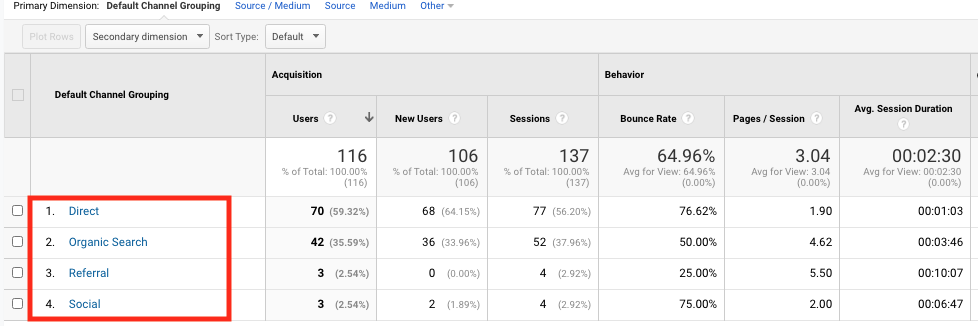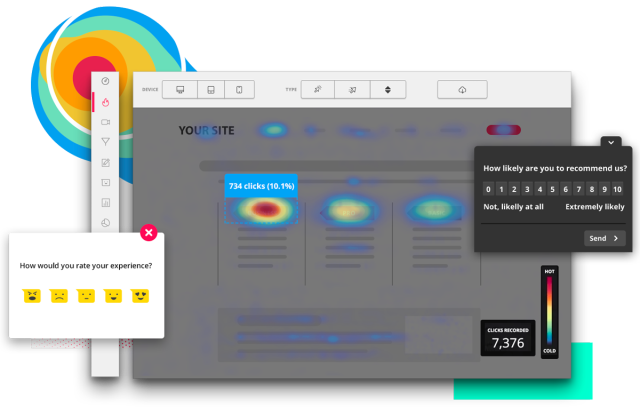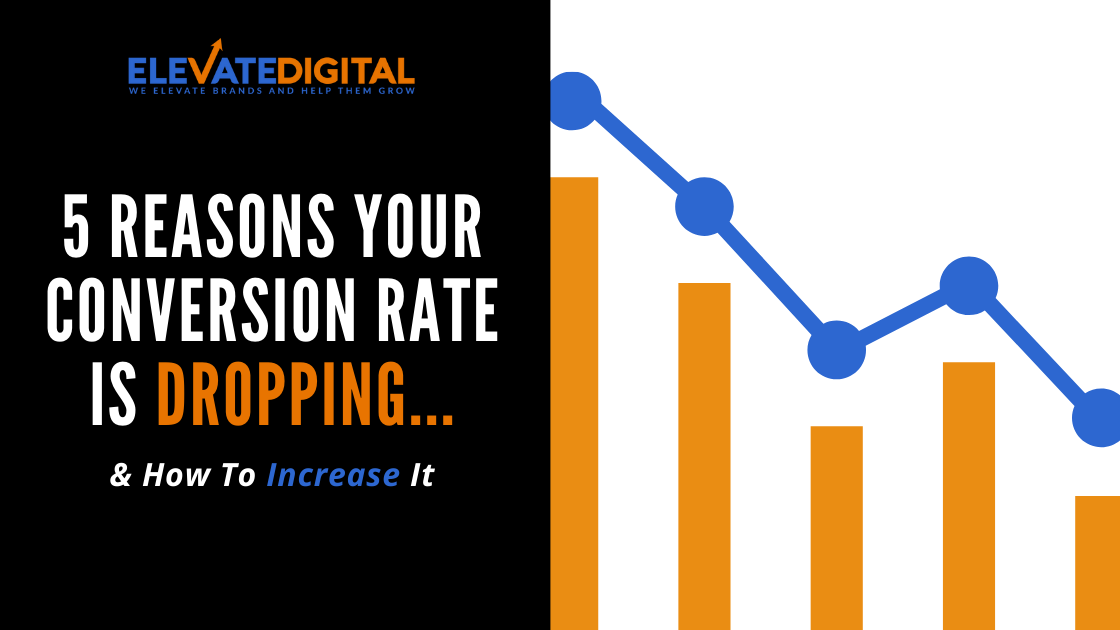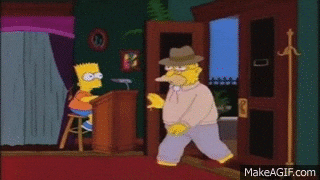If you’ve recently noticed a decrease in your conversion rate, you’re in the right place!
We’ll be guiding you through 5 of the most common causes of a conversion rate decrease and most importantly, what you can do about it!
Firstly though, it’s important to also acknowledge that conversion rate can very greatly by industry.
And whilst average website conversion rate statistics will vary depending on the source, this number tends to float around 2%, and mostly alarmingly is dropping year on year as markets become more and more saturated.
Yup, you heard that right…
That means for every 100 people who visit your site, on average, only two of them will take the desired action… (if you’re lucky!)

In the business world, it’s common knowledge that if you’re not growing, you’re dying. And while this may be true for certain aspects of a company, when it comes to website traffic and conversions, simply increasing website visits isn’t enough.
All the fastest growing businesses know that conversion rate is optimisation essential. Without converting leads into customers, your business will quickly dwindle.
So, when conversion rates drop, it’s natural to panic and search for a reason why. If your conversion rate is dropping, here are five possible causes (and how to fix them).
If you prefer video, be sure to check out our video below on optimising your conversion rate:
1. Change Of Traffic Source Or Targetting
One of the most common reasons for a drop in conversion rate is a change in traffic sources. For example, if you’ve started running ad campaigns on a new platform or targeting a different audience, it’s possible that you’re not getting as high-quality traffic as you were before.
In these cases, it’s important to take a close look at your data to see where the change occurred and whether there are any other factors that might be affecting your results.
One possibility is that the source of your traffic has changed. For example, if you’re now ranking for a certain keyword organically, you might be getting lots of new visitors to your site who aren’t necessarily relevant to your business. As a result, even though traffic is up, conversions aren’t rising in accordance with the increase in traffic…
Another possibility is that you’ve changed your targeting from an ad campaign, which could be resulting in lower quality traffic. If you’re not targeting your ads as effectively as before, you’ll likely see a decrease in conversion rate.
How To Fix?
There are a few things you can do to troubleshoot the issue. First, take a look at your analytics to see where your traffic is coming from and what changed around the time of the drop in conversion rate.

This will give you some clues as to what might be causing the problem. Then, take a look at your sales page and consider making some changes to make it more effective.
Finally, make sure you’re offering enough value and that your purchase process is as streamlined as possible. By taking these steps, you can combat the drop in your conversion rate.
2. Structural/design changes to the website
It’s common for business owners to want to make changes to their website on a regular basis. After all, the Internet is constantly evolving, and what was popular last year may not be so popular this year.
However, it’s important to remember that even small changes can have a big impact on your conversation rate. For example, if you move your “contact us” button from the top right corner of your home page to the bottom left corner, you may find that fewer people click on it.
Or, if you change the color of your “buy now” button from green to red, you may see a decrease in sales. This is because people are creatures of habit, and they often don’t like change. Even if the new design is more aesthetically pleasing or easier to navigate, they may still prefer the old one simply because it’s what they’re used to.
How To Fix?
To troubleshoot the issue, first make sure you have a record of all the changes you’ve made, along with the dates they were made. This way, you can narrow down which change might be causing the drop in conversions.
If you’ve made multiple changes, try reverting back to an earlier version of your website to see if that makes a difference.
It’s also important to avoid making too many changes at once, as this can make it difficult to determine what’s causing the increase or decrease in conversion rate.
By taking these steps, you can help identify the root cause of the problem and make necessary changes to get your conversion rate back on track. When making changes to your website, always be sure to test them out first to see how they impact your conversation rate. Otherwise, you could end up doing more harm than good.
3. A Bug On The Site
Any business owner will tell you that a website is essential for driving conversions. After all, it’s the first point of contact between a potential customer and your brand.
If your website is unusable or difficult to navigate, you’re likely to lose customers before they even have a chance to engage with your product or service. In other words, a bug on your website can have a major impact on your conversion rate.
Website bugs can be detrimental to a business – especially if they go unnoticed for a long period of time. Not only do they frustrate customers, but they can also lead to a drop in conversion rates.
In fact, a study by IBM found that nearly two-thirds of online shoppers have abandoned a purchase due to a technical issue. While some bugs may be difficult to spot, it’s important to regularly test your website to ensure that everything is working properly.
How To Fix?
The good news is that there are steps you can take to prevent these kinds of issues from happening in the first place. By investing in quality web design and testing your site regularly, you can help ensure that your website is always up to par. An easy way to spot these issues is to use something like Hotjar to watch back session recordings and find where people are dropping off the site.
In addition, by keeping an eye out for potential bugs and fixing them as soon as they’re found, you can help minimize the damage to your conversion rate. In short, though a bug on your website can be costly, there are steps you can take to prevent it from happening in the first place, and to minimize the damage if it does occur.

4. Industry Being Disrupted Due To Competitors
Disruptive companies are those which identify and exploit weaknesses in traditional businesses. In many industries, the weakest link is often the customer service department.
This was the case with online mattress companies, who fully embraced the online shopping model by creating a no-brainer irresistible offer that removed almost ALL friction for potential buyers.
For example start-ups like Simba and Casper mattresses recently dominated the incumbents by doing exactly this.
Their offers of effortless free delivery and 100-night risk-free trials made it hard for other companies (even well established businesses) to compete.
Were they the first companies to offer this? Maybe not – but they understood how to get their message heard.
The key lesson from this is that it’s important to always keep your ear to the ground in your space. Not just what’s happening, but what’s coming. Changes to consumer behaviour can be a major threat to any business, so it’s important to stay ahead of the curve.
How To Fix?
If you’re noticing that your conversion rate is dropping because of industry disruption, there are a few things you can do to try to fix the issue. First, take a look at your pricing. If your prices are too high, potential customers may be going to your competitors who are offering lower prices.
You may need to adjust your offer (not necessarily pricing) in order to stay competitive. Another thing to look at is your marketing strategy. Are you still using the same marketing methods that you’ve always used?
If so, it’s possible that your target audience has changed and you need to update your approach. Finally, make sure that you’re providing excellent customer service. If potential customers have a bad experience with your company, they’re unlikely to convert.
Get A FREE Conversion Rate Audit 📈
Book your FREE website and marketing audit today and we’ll record you a 15-minute personalised video showing you your main conversion bottlenecks and how to fix them.
5. Potential Tracking Issues
Has your conversion rate dropped despite steady sales? It may be due to tracking issues. Tracking issues can occur on the ad platform side or within Google Analytics. If conversions are being tracked incorrectly, it will appear as though your conversion rate has dropped when sales have remained steady.
How To Fix?
To fix this issue, check your tracking code to make sure it is installed correctly and firing properly. You may also need to adjust your tracking pixel so that it only tracks conversions that occur on your site. You’ll also want to ensure there aren’t duplicate codes or outdated tracking plugins.
By ensuring that your tracking code is installed correctly and your tracking pixel is configured correctly, you can ensure that your conversion rate is reported accurately.
Other Common Causes Of A Low Conversion Rate
What if your conversion rate hasn’t dropped but you are just experiencing a low conversion rate in general? Well there are a number of common things we see that could be causing a low overall conversion rate on your website.
1. High amount of blog traffic or information search rankings
We often see websites that rank in Google for a lot of ‘information’ search terms, meaning the visitor has landed on a blog or article on your website because there were looking for information or an answer to a specific question.
Naturally this kind of traffic will have a lower conversion rate than “commercial” search terms when somebody is actively looking for your specific product or service and as such, can bring down your overall website CVR%
2. You’re in a very saturated market with no clear differentiator
Most markets these days are becoming increasingly saturated. As such, it’s critical you can create unique positioning for your brand that helps separate you from the noise. To do this, you need to first understand your customer avatar, the specific segment of the market you are target and what stage of saturation or sophistication that market is currently at.
Our video explains this concept in more detail:
3. You haven’t conveyed enough trust/credibility
Showcasing testimonials and other trust-signals on your website as early as possible is critical to building trust. Especially when consumer trust is already at an all-time low.
Make sure you’re properly leveraging testimonials and reviews on your website to build trust before users decide to bounce.
A good exercise here is to look at some of your top competitors, and ask yourself honestly
“If I was already sceptical and had no heard of my business before, would I really bother contacting or buying from my business, when I have these other more trusted options available?”
4. There is a lack of congruency between your marketing and your website
If your market is talking about a specific product or service offering but you’re then sending people to your homepage, this can cause a lack of congruency, resulting in a high-bounce rate and low conversion-rate as people don’t see what they were expecting.
The best way to overcome this is to create specific category, industry, or service based pages on your website and ensure you’re driving people to the right page for each stage of the marketing funnel.
5. You don’t have a compelling product or product-market-fit
If you’re a new start-up and haven’t yet validated demand for your product/service by actually selling it (BTW people just registering interest does not class as validation), and you’re seeing a low-conversion rate out of the gate…
You have to eventually face the reality that you may just not have a product-market-fit or have a compelling enough offer at a compelling enough price point.
Ready To Diagnose Your Drop in Conversion Rate?
If your website’s conversion rate has been dropping recently, it can be frustrating and costly.
But by considering these 5 factors, you should be well on your way to finding the root cause and increasing your conversion rate back to healthy numbers!
Have you tried any of these techniques before? Let us know how they worked for you!
- Highly-Effective DTC Marketing Strategies & Examples - February 28, 2024
- How To Set Paid Media Marketing Budget - October 16, 2023
- The Ultimate Guide To A/B Testing - September 23, 2023






